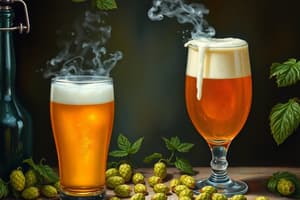Podcast
Questions and Answers
Which of these is the primary grain used in beer making?
Which of these is the primary grain used in beer making?
- Rice
- Wheat
- Barley (correct)
- Corn
What is the primary purpose of the malting process?
What is the primary purpose of the malting process?
- To add bitterness to the grains
- To filter out unwanted flavors from the grains
- To introduce carbonation to the grains
- To convert starches into fermentable sugars (correct)
What process separates the liquid wort from the spent grains?
What process separates the liquid wort from the spent grains?
- Conditioning
- Mashing
- Lautering (correct)
- Fermentation
Why is the boiling stage important in wort production?
Why is the boiling stage important in wort production?
What is the role of yeast in the fermentation stage?
What is the role of yeast in the fermentation stage?
What is involved in the conditioning stage of beer making?
What is involved in the conditioning stage of beer making?
Which of the following is NOT a quality control measure used to evaluate beer?
Which of the following is NOT a quality control measure used to evaluate beer?
What is 'force carbonation'?
What is 'force carbonation'?
Flashcards
Barley
Barley
The primary grain used in brewing, often malted to develop specific flavors and colors.
Malting
Malting
A process where barley is germinated to activate enzymes, converting starches into fermentable sugars.
Milling
Milling
The process of grinding grains into a powder, preparing them for further processing.
Mashing
Mashing
Signup and view all the flashcards
Hops
Hops
Signup and view all the flashcards
Fermentation
Fermentation
Signup and view all the flashcards
Conditioning
Conditioning
Signup and view all the flashcards
Beer Styles
Beer Styles
Signup and view all the flashcards
Study Notes
Ingredients and Mashing
- Barley is the primary grain, often malted to develop specific flavors and colors.
- Other grains like wheat, rice, or corn may be added for different characteristics.
- Hops are crucial for bitterness, aroma, and preservation.
- Yeast is necessary for fermentation, converting sugars into alcohol and carbon dioxide.
- Water quality significantly impacts the final beer flavor.
Malting
- Malting involves germinating barley to activate enzymes.
- This process converts starches into fermentable sugars.
- Different malting methods result in varying degrees of color and flavor.
- Specific malts provide diverse flavors and color to the beer.
Brewing Process
- Milling is the stage where the grains are ground into a powder or grist.
- Mashing is the process of mixing the grist with hot water to convert starches into sugars.
- Lautering separates the liquid wort from the spent grain.
- The wort is boiled with hops to extract their flavor and aroma, sterilize the liquid, and adjust the color.
- Fermentation involves adding yeast to the cooled wort.
- Yeast converts sugars into alcohol and carbon dioxide.
Wort Boiling
- Boiling is critical for sterilizing the wort, inactivating enzymes, and increasing its stability.
- Adding hops during boiling imparts bitterness, aroma, and flavor.
Fermentation
- Temperature control is essential for yeast activity and product quality.
- Yeast strains are selected to achieve specific alcohol levels and flavor profiles.
- Fermentation leads to the production of alcohol and carbon dioxide.
Post-Fermentation
- Conditioning allows the beer to age and improve its flavor and consistency. Depending on the style of the beer, this may include bottle conditioning or keg conditioning.
- Carbonation may be added through a process called force carbonation.
- Filtering and clarifying remove any suspended particles.
Packaging
- Bottles, cans, or kegs are common packaging methods.
- Each method has unique considerations for distribution and consumer experience.
Beer Styles
- Beer styles are categorized based on ingredients, brewing process, and desired final characteristics.
- Examples of these styles include stouts, lagers, ales, IPAs, etc.
Quality Control
- Sensory evaluation is vital for assessing beer quality, including color, clarity, aroma, flavor, and mouthfeel.
- Chemical analyses measure key parameters like alcohol content, bittering units, and pH.
- Maintaining hygiene and sanitation throughout the brewing process is crucial for food safety.
Studying That Suits You
Use AI to generate personalized quizzes and flashcards to suit your learning preferences.




